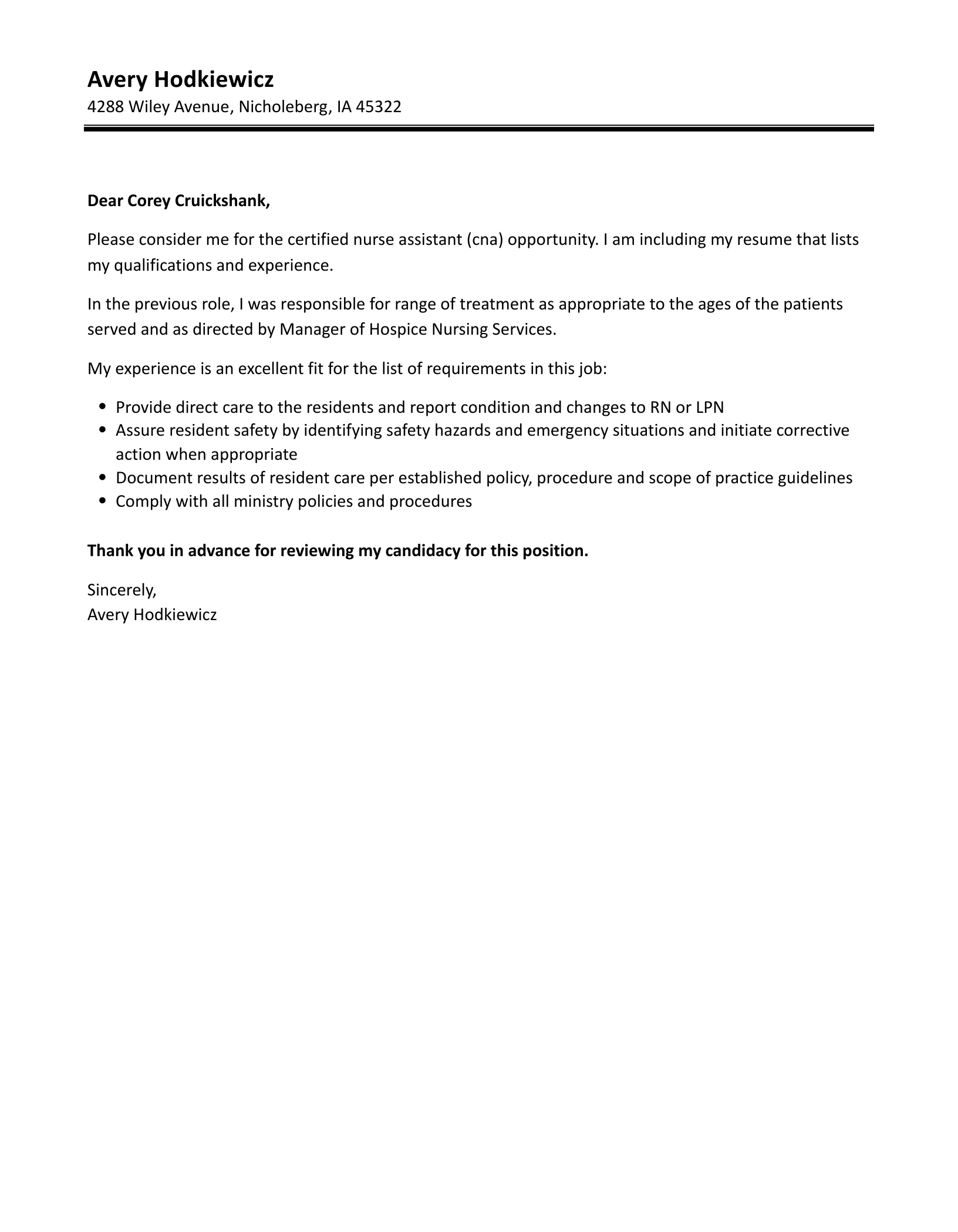Crafting a CNA Cover Letter that Shines
A Certified Nursing Assistant (CNA) cover letter is your first opportunity to make a positive impression on a potential employer. It’s a crucial document that complements your resume, providing a more personal and detailed insight into your qualifications, skills, and enthusiasm for the role. A well-written cover letter can significantly increase your chances of landing an interview, setting you apart from other applicants. This guide provides comprehensive insights into crafting a compelling CNA cover letter that effectively highlights your strengths and showcases your passion for patient care. It is essential to go beyond a mere reiteration of your resume; instead, use the cover letter to tell your story, demonstrating why you are the ideal candidate for the specific CNA position.
Understanding the Purpose of a CNA Cover Letter
The primary goal of a CNA cover letter is to persuade the hiring manager that you possess the skills, experience, and personality traits necessary to excel in the position. Unlike a resume, which provides a factual overview of your qualifications, a cover letter allows you to express your personality, communicate your career goals, and explain why you are particularly interested in this specific opportunity. It gives you the chance to demonstrate your understanding of the employer’s needs and to articulate how your skills align with those needs. The cover letter should also reflect your professionalism, attention to detail, and communication skills – all essential qualities for a CNA. Therefore, crafting a tailored cover letter is not merely an option, but a necessity to stand out from the crowd and showcase your suitability for the role.
Key Elements to Include in Your CNA Cover Letter
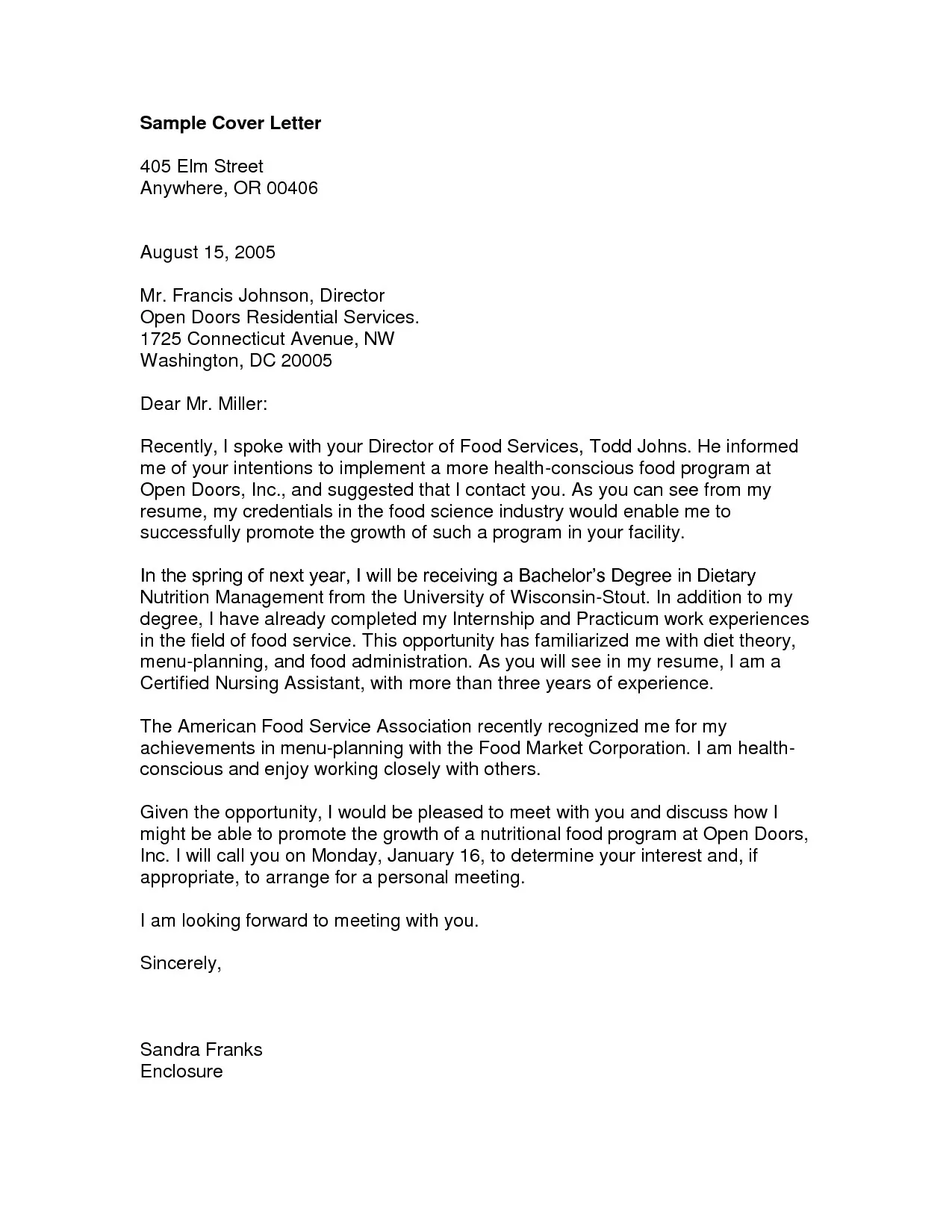
A well-structured CNA cover letter consists of several key elements that work together to create a strong impression. These elements include your contact information and the date, a professional greeting, a compelling opening paragraph, a detailed section on your skills and experience, relevant certifications and training, quantified achievements, and an expression of your passion for patient care. Moreover, you must tailor the letter to the specific job description, research the employer, and use keywords from the job posting to show your suitability. The closing should reiterate your interest, include a call to action, and offer thanks for their time. Careful attention to these elements, coupled with thorough proofreading, will ensure your cover letter is impactful and professional.
Contact Information and Date
Start with your full name, address, phone number, and email address. Place this information at the top left of your cover letter. Directly below your contact information, include the date on which you are submitting the cover letter. Ensuring your contact information is accurate is crucial, as it’s the only way for the employer to reach you. Always double-check the accuracy of your phone number and email address before sending the cover letter to prevent any communication mishaps. Also, it is essential to use a professional-sounding email address. For example, use your full name rather than a casual nickname, as this helps project a professional image.
The Greeting
The greeting sets the tone for your cover letter, and it’s important to make it professional and personal. If possible, address the hiring manager by name. This demonstrates that you’ve taken the time to research the company and the role. Start with “Dear Mr./Ms./Mx. [Last Name].” If you can’t find a specific name, you can use a general greeting like “Dear Hiring Manager” or “Dear [Department Name] Hiring Team.” Avoid overly casual greetings. Always spell the name correctly, and if you’re unsure of the correct spelling or gender, it’s best to use a general greeting to play it safe. A well-crafted greeting demonstrates respect and shows that you’ve considered who will be reading your application.
Highlighting Your CNA Skills and Experience
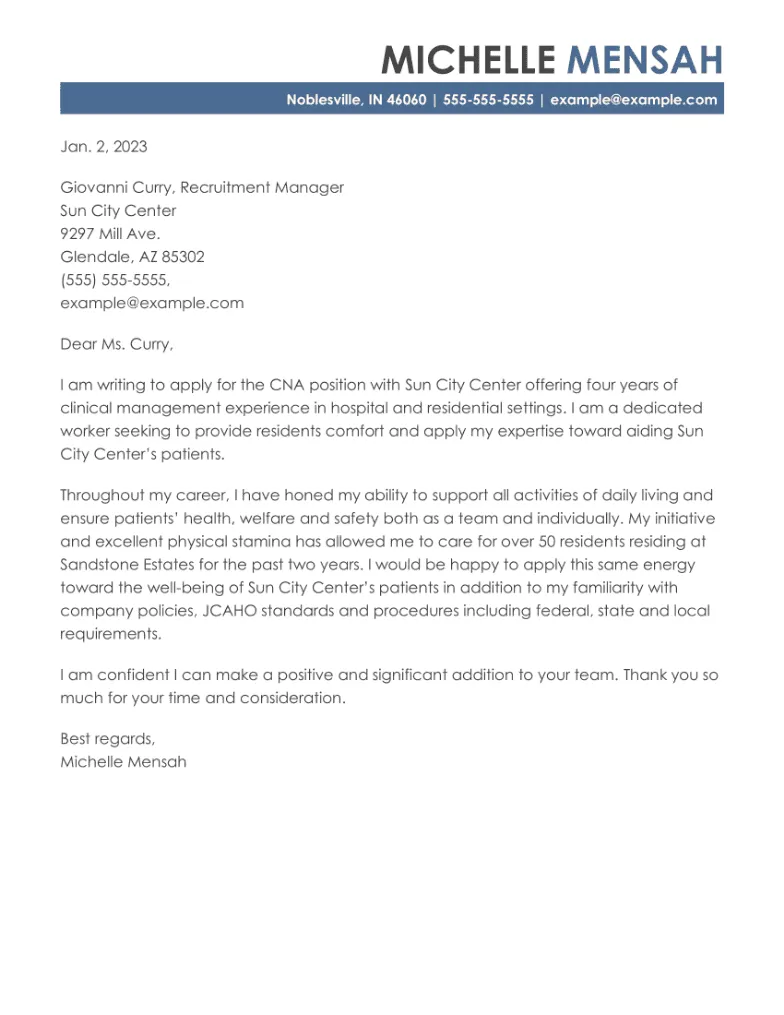
Your CNA skills and experience are the core of your cover letter, so be sure to showcase them effectively. Focus on the skills and experiences that directly relate to the job description. Provide specific examples of how you’ve demonstrated these skills in previous roles. Instead of merely listing your duties, explain how you’ve applied your skills to provide excellent patient care. For example, instead of saying “Assisted patients with daily living activities,” write “Provided compassionate care to patients by assisting with daily living activities, including bathing, dressing, and feeding, ensuring their comfort and dignity at all times.” This allows the hiring manager to quickly understand your abilities and your approach to your work. The more specific and detailed you are, the better.
Showcasing Relevant Certifications and Training
Highlight any relevant certifications and training you have obtained, such as your CNA certification, CPR certification, First Aid certification, and any specialized training. Mention the name of the certification, the issuing organization, and the date of certification. For example, write “Certified Nursing Assistant (CNA) certified by [Certifying Organization] since [Date].” If you have completed additional training, like dementia care, or experience with specific medical equipment, make sure to mention those too. Ensure that your certifications are up-to-date and valid. This part of your cover letter confirms to the employer that you meet the minimum requirements for the job and that you have invested in your professional development.
Quantifying Your Achievements as a CNA
Quantifying your achievements means providing measurable data to demonstrate your impact in previous roles. Use numbers and statistics to show how you’ve improved patient outcomes, increased efficiency, or contributed to a positive work environment. For example, instead of writing “Provided excellent patient care,” write “Consistently maintained a 98% patient satisfaction rating through attentive and compassionate care.” or “Reduced patient fall incidents by 15% through proactive safety measures.” Quantifiable achievements help the hiring manager see tangible results and understand the value you will bring to their team. Use metrics and statistics to support your claims, making your cover letter more compelling and persuasive.
Expressing Your Passion for Patient Care
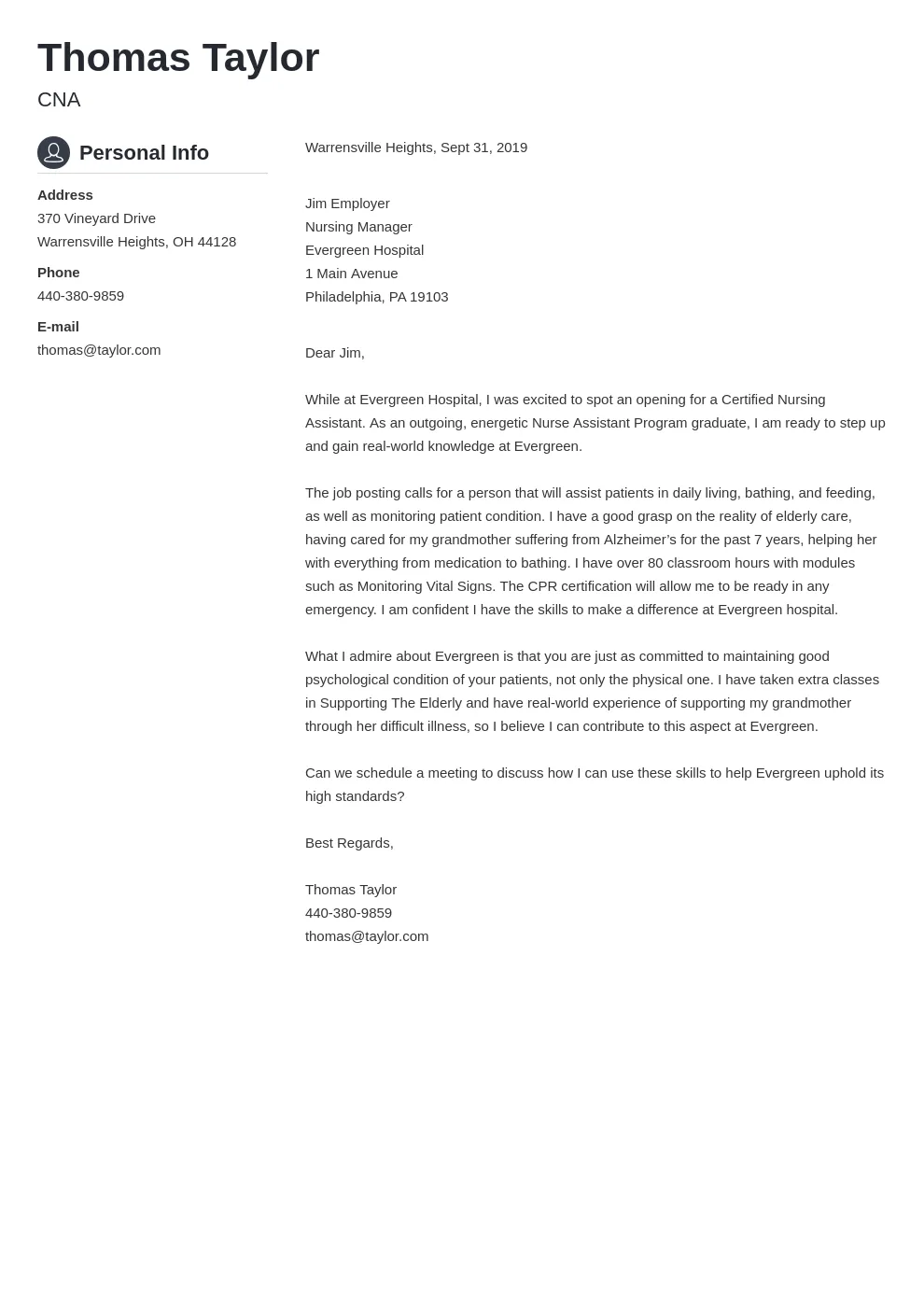
Express your genuine passion for patient care to connect with the hiring manager on a personal level. Explain why you chose this career path, what motivates you to provide care, and the values you uphold. Share your dedication to helping others, your commitment to providing comfort and support, and your enthusiasm for making a difference in patients’ lives. Be authentic and sincere in your expression. For example, state “I am deeply passionate about providing compassionate and dignified care to patients, and I am committed to ensuring their well-being and comfort.” When you express your empathy and compassion, your cover letter becomes more memorable and relatable. Employers often seek CNAs who show empathy, a strong work ethic, and genuine care.
Tailoring Your Cover Letter to the Job Description
Tailoring your cover letter to the specific job description is crucial for demonstrating that you’ve carefully reviewed the position’s requirements and that you are a strong fit for the role. Identify the key skills, qualifications, and responsibilities outlined in the job posting. Then, in your cover letter, directly address these requirements, highlighting your relevant skills and experiences. Use the same keywords and phrases that the employer uses in the job description to show that you understand the role and are a strong match. Avoid a generic, one-size-fits-all cover letter. Instead, customize each cover letter to reflect the specific needs and expectations of the employer and the role you are applying for, demonstrating that you are attentive and willing to customize your work for the job.
Researching the Employer and the Role
Before you write your cover letter, conduct thorough research on the employer and the role. Learn about the healthcare facility’s mission, values, and the types of patients they serve. Visit their website, read reviews, and check their social media profiles to gather insights. Understanding the employer’s culture and values helps you tailor your cover letter to demonstrate that your values align with theirs. Also, review the job description carefully to understand the role’s specific responsibilities and expectations. Researching the employer shows that you’re genuinely interested in the opportunity. Incorporate what you learn in your cover letter to show you’re informed and prepared.
Using Keywords from the Job Posting
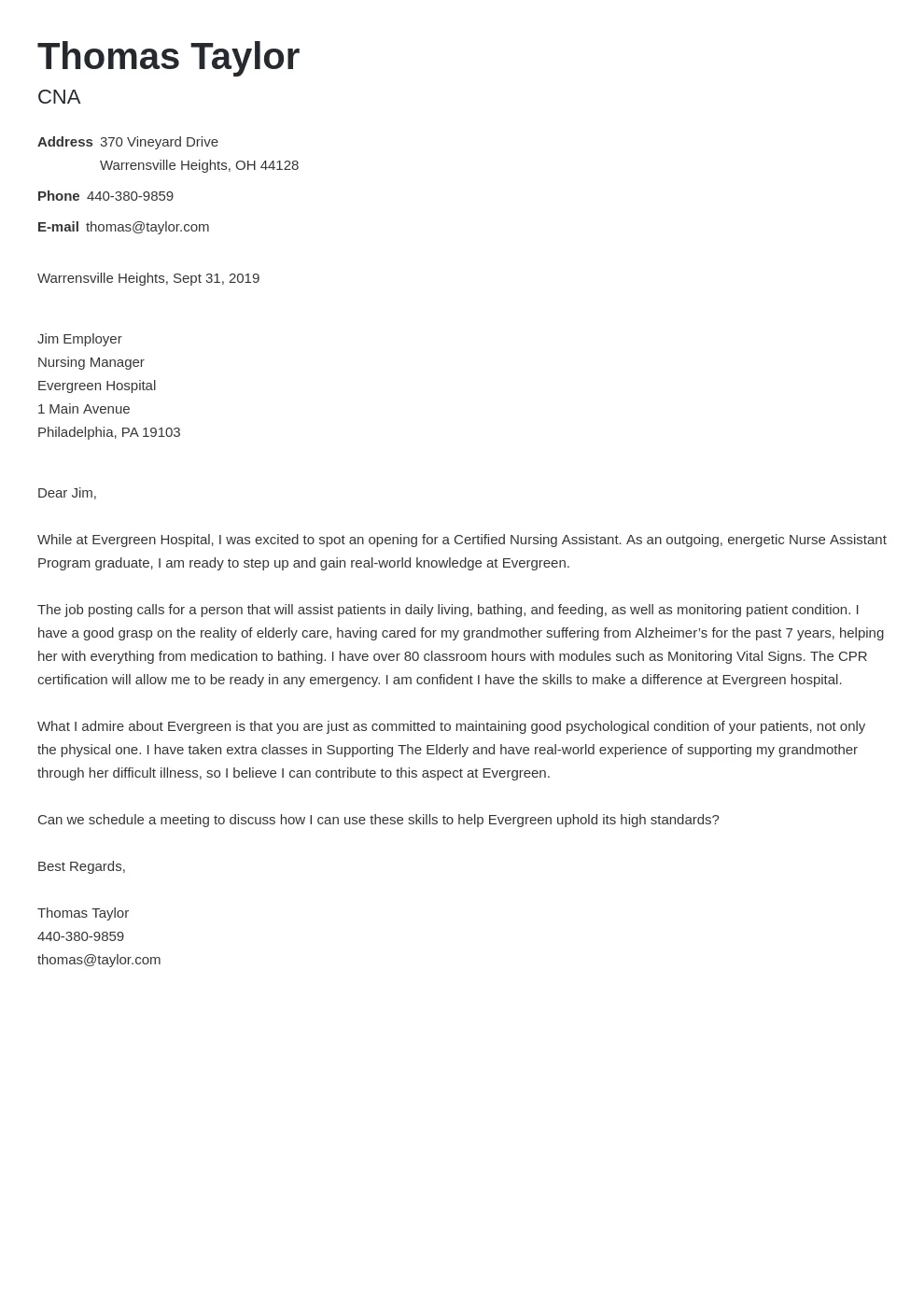
Job descriptions often contain specific keywords that employers use to identify the ideal candidates. Carefully review the job posting and identify the keywords and phrases that describe the required skills, experiences, and qualifications. Incorporate these keywords naturally into your cover letter. This helps the hiring manager quickly see that your skills align with their needs. Use these words in your descriptions of your skills, accomplishments, and experiences. Be careful not to overuse keywords. Make sure your cover letter reads naturally. The goal is to align your qualifications with the job requirements and highlight your suitability for the role.
Demonstrating Your Understanding of the Facility’s Needs
Show that you understand the healthcare facility’s needs by incorporating relevant information into your cover letter. Discuss how your skills and experiences align with their mission and values. Address specific challenges the facility might face and explain how you can help. If the facility specializes in a particular area of care, such as geriatric care or rehabilitation, highlight your experience or interest in that area. Demonstrate your knowledge of the facility and the role, as well as your ability to contribute effectively to their goals and objectives. This shows the hiring manager that you are committed to helping the facility succeed.
Writing a Compelling Closing
The closing of your cover letter is your last opportunity to make a strong impression. Summarize your key qualifications and reiterate your interest in the position. Be concise and enthusiastic. Express your confidence in your ability to contribute to the team. Thank the hiring manager for their time and consideration. Reiterate your enthusiasm for the role and your commitment to providing excellent patient care. The closing should leave the hiring manager with a positive final impression and encourage them to contact you. Always end with a professional closing, such as “Sincerely” or “Best regards,” followed by your full name.
Reiterating Your Interest and Availability
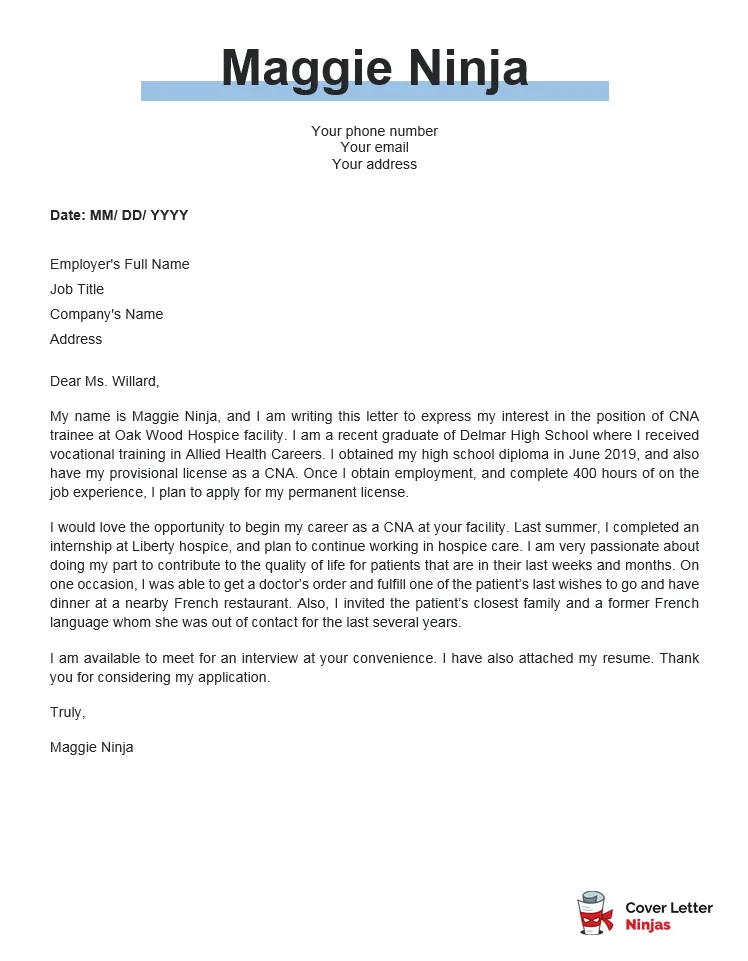
In your closing paragraph, reiterate your interest in the position and your enthusiasm for the opportunity. Reiterate your commitment to patient care and your eagerness to contribute to the healthcare facility’s mission. Make it clear that you are available for an interview. Include a sentence like, “I am very interested in this position and I am available for an interview at your earliest convenience.” This shows your enthusiasm and willingness to move forward in the hiring process. By clearly stating your interest and availability, you make it easy for the hiring manager to take the next step and contact you.
Including a Call to Action
Include a call to action to encourage the hiring manager to take the next step. This could be a simple statement like, “I look forward to hearing from you soon” or “I am available for an interview at your earliest convenience.” This prompts the hiring manager to contact you and move forward with the application process. Make it easy for them to reach you by including your phone number and email address in your closing. A strong call to action demonstrates your initiative and eagerness to advance in the hiring process. The call to action is essential for encouraging the hiring manager to take the next steps.
Proofreading and Formatting Your CNA Cover Letter
Proofreading and formatting are critical steps in the cover letter writing process. A well-proofread and formatted cover letter presents a professional image and demonstrates your attention to detail. Ensure that your cover letter is free from errors in grammar, spelling, and punctuation. Use a spell checker and grammar checker to catch mistakes. Have someone else read your cover letter to provide a fresh perspective and catch any errors you may have missed. Proper formatting enhances readability and makes your cover letter easier to navigate. The goal of proofreading is to present a professional cover letter that reflects your skills and abilities accurately. Taking these steps ensures your cover letter makes a strong impression.
Checking for Grammar and Spelling Errors
Thoroughly check your cover letter for any grammar and spelling errors. Errors can detract from your professionalism and credibility. Use a spell checker and grammar checker to catch potential mistakes. Read your cover letter multiple times, slowly and carefully. Consider reading it aloud to catch awkward phrasing or typos. Ask a friend, family member, or career advisor to review your cover letter to provide a fresh perspective. Proofreading can catch errors. Always proofread your cover letter to ensure it is error-free and professional. This can make a great impact on the employer.
Formatting Guidelines for a Professional Look
Follow formatting guidelines to ensure your cover letter has a professional look. Use a standard font, such as Times New Roman, Arial, or Calibri, in a readable size, such as 11 or 12 points. Use single spacing within paragraphs and double spacing between paragraphs. Use clear headings and bullet points to organize your content. Maintain consistent margins throughout the document. Use a professional layout to ensure the cover letter is easy to read. Ensure your cover letter is clean, well-organized, and easy to read. This formatting shows attention to detail and that you are a professional applicant. Proper formatting helps to make the cover letter visually appealing and makes it easier for the hiring manager to read and understand.
Examples of Effective CNA Cover Letter Phrases
Using effective phrases can greatly enhance your cover letter. Here are some phrases to help you highlight your skills, compassion, and teamwork abilities. Using these phrases can help you communicate effectively and show your enthusiasm and expertise in a concise manner. Choosing the right words can demonstrate your qualities and skills to stand out.
Phrases to Use to Highlight Your Skills
To highlight your skills, use phrases that directly relate to the responsibilities of a CNA. Examples include: “Proficient in providing direct patient care,” “Experienced in assisting with activities of daily living,” “Skilled in monitoring and recording vital signs,” “Competent in providing medication reminders,” “Experienced in assisting patients with mobility,” “Knowledgeable in wound care and infection control,” “Strong ability to maintain patient records,” “Proficient in using medical equipment,” and “Able to communicate effectively with patients and their families.” These phrases should be used in a way to explain your ability to perform the duties of a CNA.
Phrases to Express Your Compassion
To express your compassion, use phrases that demonstrate your empathy and care for patients. Examples include: “Dedicated to providing compassionate care,” “Committed to promoting patient comfort and well-being,” “Passionate about making a positive difference in patients’ lives,” “Approachable and supportive, building trust with patients,” “Providing emotional support,” “Committed to treating each patient with dignity and respect,” “Ensuring a safe and caring environment,” and “Dedicated to providing personalized care.” Use these phrases to highlight your human side, showing how you connect with and care for patients.
Phrases to Showcase Your Teamwork
To showcase your teamwork abilities, use phrases that demonstrate your ability to collaborate with colleagues. Examples include: “Collaborative and team-oriented,” “Excellent communication skills, working with the team to ensure the best patient care,” “Committed to working collaboratively with nurses, doctors, and other staff,” “Effective at communicating patient needs to the healthcare team,” “Supportive team member, assisting colleagues as needed,” “Working effectively to ensure a safe and efficient work environment,” “Participating in team meetings to improve patient care,” and “Consistently providing a positive and supportive work environment.” These phrases show that you work well with others and contribute to a collaborative environment.
Mistakes to Avoid in Your CNA Cover Letter
There are several mistakes you should avoid when writing a CNA cover letter to ensure it makes a positive impression. Avoiding these common mistakes will help your cover letter stand out. Make sure you are clear and avoid errors that may result in a rejection of your application. Avoiding these errors will help you avoid issues in your application.
Common Errors that Can Cost You the Job
Common errors can prevent your application from succeeding. Avoid making generic, overused phrases. Tailor your application for the specific job. Do not submit a cover letter that contains spelling and grammar errors. Always proofread your cover letter to ensure it is professional. Pay careful attention to detail, and double-check everything before submitting.
Overusing Generic Language and Clichés
Avoid using generic language and clichés, as they make your cover letter sound unoriginal. Phrases like “hardworking,” “team player,” and “detail-oriented” are overused and don’t provide specific details about your skills and experiences. Instead, use specific examples to demonstrate your skills. Instead of saying, “I am a team player,” describe a specific instance where you worked collaboratively with others. Avoid common phrases. Make your cover letter unique, and highlight your key skills.
Ignoring the Job Description and Employer Needs
Failing to tailor your cover letter to the job description is a major mistake. Ignoring the specific requirements and expectations of the job can make it seem like you’re sending a generic application without taking the time to carefully read the requirements. Always review the job description thoroughly and address the specific needs of the employer. Show that you understand the role and have what it takes to succeed. Ensure your cover letter highlights the skills and experiences that match the employer’s requirements. By addressing specific needs, you demonstrate that you are a good fit and show the employer that you are the right candidate for the job.
Submitting a Cover Letter Without Proofreading
Submitting a cover letter without proofreading is a serious mistake that can undermine your credibility. Spelling and grammar errors, typos, and formatting inconsistencies will make a bad impression on the hiring manager and make you look careless. Always proofread your cover letter carefully before submitting it. Use spell check and grammar check tools, and consider having someone else review your cover letter. A polished, error-free cover letter shows that you pay attention to detail and take pride in your work. Always check before you submit to catch mistakes.
